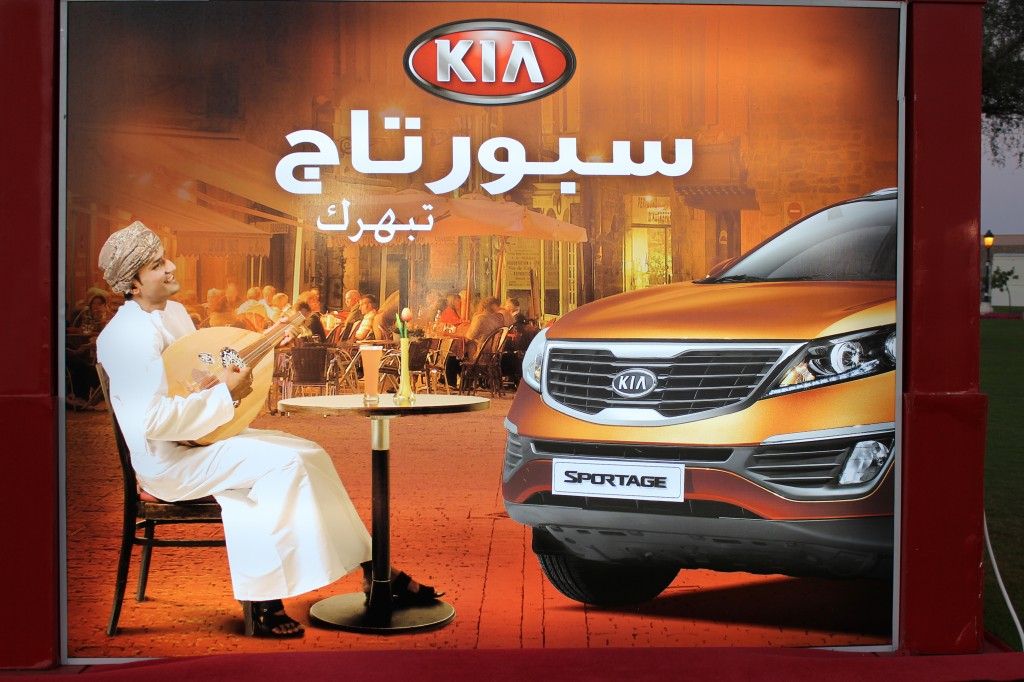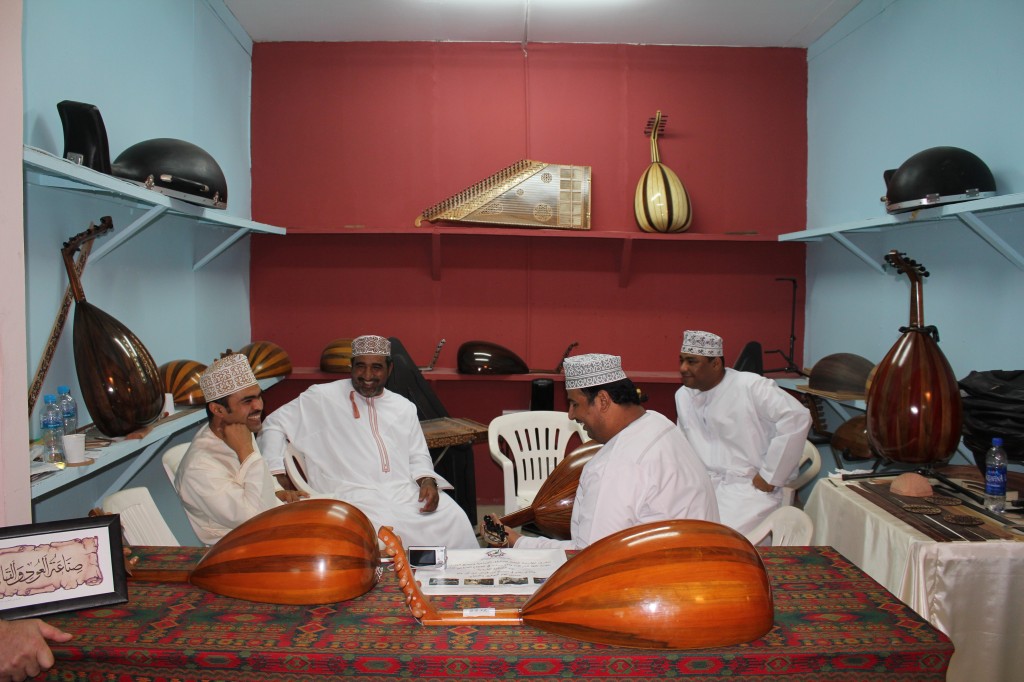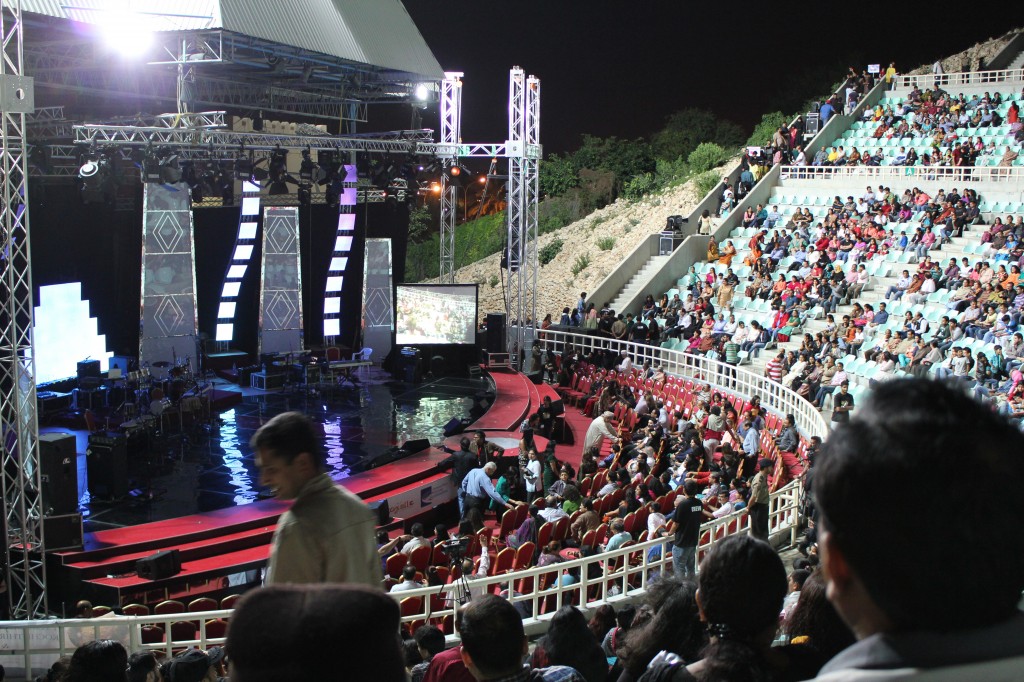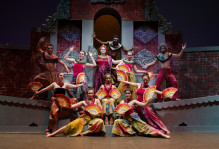AKR in Oman Part 2 #2: Bollywood in Oman
AKR in Oman Part 2 #2: Bollywood in Oman
I left the Beach Hotel at 4:20 on foot to arrive at Qurum (also Qorm) Natural Park after 40 minutes of brisk walking in the hot humid and windy afternoon. Friday afternoon is like Sunday in the U.S.; folks were out on Love Street and on the beach, walking, picnicking, and playing soccer. When I arrived, I bought my ticket for 200 baisa at the window marked “women,” entered the park and headed across the vast animated space of exhibitions, food booths, fountains, and lawn to where I thought the amphitheater was located. There was nothing going on there – just a few people hanging around and when I asked about the Indian concert of the Bollywood star Sonu Nigam all I got was blank looks. This annoyed me as quarter-page color ads for the concert were in every newspaper for the last week. I wandered back into the park area looking for someone with a badge who could tell me where the Qurum Amphitheater was. I found an official and he directed me back toward the opposite entrance. Indeed the amphitheater was located just outside the park.
Three days earlier I met a radio anchor-woman who snagged me for a live interview in English. She was from the Indian community here and when I expressed interest in the concert and in the other Indian music activities in the city her eyes lit up; in fact her husband was organizing the concert by Sonu Nigam, the “voice of Bollywood,” that I had been reading about. I hoped that maybe my new connection to the Indian art world in Muscat could put me on a guest list or at least secure me a ticket but my texts, calls and email produced no response.
I presented myself at the gate, tired from tramping around for now what was two hours. Sold Out! Damn! But then someone was hanging around and his family wasn’t all coming so he had a couple of tickets to sell. 25 Omani Riyal or about 65 dollars, way more than I wanted to pay. But I hardly have daily expenses beyond my hotel and rental car and as Indian music is clearly an element in the musical tapestry here I thought I should attend an event. Furthermore the concert was part of the Muscat Festival which has a huge international component of artists and performers. Plus, I teach a unit on Indian music of some sort in my classes at least once a year. Although still early, I was tired and the thought of just sitting down for a while seemed delightful.
My seat, in an amphitheatre that must have held at least 5,000, was pretty good. I was glad I spent the money and it was fun to watch the crowd. I chatted with a family of four in front of me. The father was the director of Suzuki Motors in Oman and we agreed that cars are very important here (camels, horses). The crowd was distinctive from the large crowds I had been in for the National Day events I attended in November and December 2010 during my first trip to Oman.

Figure 1: One of the tents for the many car companies represented here. There must be at least 50 new cars of all models around the festival grounds. The ‘ud player and café scene in the background caught my eye.
First, men, women, and children all sit together – there was no separate section for women. Second, Indians are recognizable for their dress: they either wear Indian fashion, like salwar kameez (khamis) or saris, or international clothes, like jeans. Only Omanis wear Omani clothes, and most women wear an array of fashion from a black abaya and headscarf, both with elegant trim, or just long dresses with or without headscarves, men wear the dishdasha and a turban or cap. I think it is safe to say that no Omanis, except for some of the younger shabab (guys, youth) wear pants. So Indians look different. And, there are a lot of them. Out of about 2.5 million inhabitants in Oman 500-600 thousand are expats and of that population about 70% are South Asian (Indians, Bangladeshis, and Pakistanis) and the majority of these are Indians from Kerala. I had been noticing editorials by Indian authors in the three English language papers here, The Observer, The Muscat Daily, and the Times of Oman. And there is often news of happenings in Indian schools. Furthermore there is reporting on Indian performing arts, either events that are happening in Muscat or reviews of events and celebrities from India. My neighbors in the amphitheater told me that there are six Indian schools in Muscat (through 12th grade) and perhaps another 4 in Oman’s other biggest cities, like Sohar and Salala. So the presence of Indian arts and crafts and now this mega concert were not a surprise.
Sonu Nigam promised to please and he proved to be a versatile and charismatic performer backed up by a hot band and 8 dancers. An emcee and a comedian took turns addressing the audience, calling out, to all of the various ethnic groups and regaling the crowd with self-depreciating humor (imitating various accents and mannerisms) before the superstar came out. The emcee said you get 6 million pages when you google Sonu Nigam. I just did it and got 3,444,000. He is singer, composer, actor, radio and television host – he’s a culture maker. One of the highlights of his show was when he demonstrated how a song is made. The audience called out various names of vegetables (Aloo, Gobi — potatoes, cauliflower . . .) and he did it. He created a “vegetable song” adding bass, guitar, percussion, keyboard, and then improvising his new hit in various Indian classical and popular styles.
Although the concert was ready to start at 7 as planned it was delayed by 40 minutes in respect for the evening prayers. I thought this just a bit odd because inside the park music always seemed to be really gearing up right around 7:30. The concert finally started at 8, and I left at 10, already late for a promised stop at the well-known maker of ‘uds and qanuns, Ali al-Sabsabi who has a shop in the international pavilion. The Syrian ‘ud-maker’s shop is in the International Pavilion that includes nine wings or hallways, each with about 14 stalls featuring arts and crafts from four central Asian nations and Iran, South Africa, Senegal, Pakistan, India, Turkey, Macedonia, Mexico, Japan, France, and the Arab nations of Egypt, Syria, Tunisia, Mauritania, Algeria and the state of Palestine as it is called here.
A miraculous turn of events occurred at Ali’s shop. First, the first words out of Mr. Sabsabi’s mouth were “Jonathan Shannon,” the name of a friend we have in common and a colleague who readers of this blog may know. Second, one of the artisans in the Syrian wing, a glass artist, has a marvelous voice and I was able to show off my repertoire of Syrian muswashshahat (in a land where they are not really heard and played) in a lively jam session. And third, after receiving the message that I would never be able to attend a rehearsal of the Sultan’s Firqah (Arabic orchestra) due to Palace security, I met Rami, a young qanun player from the palace group. So, as it turns out, even though I can’t get in, the musicians do circulate in the world and it will be good to get to know of this special royal ensemble, the only one like it in the Arab world, from these very friendly musicians (I have already met two of them).

Ali Al Sabsabi's shop. Pictured are Fathi Mohsin, Director of the ‘Ud Hobbyist Assocation, TV anchor person Abdullah Al Sabah, Saif Al Wahabi, musician and producer from the Ministry of Education, and Saif al Wahaibi, qanun player and teacher at the Ministry of Culture
After the visit and impromptu jam session at Ali Sabsabi’s shop I walked back out of the park with Rami and his friend who were giving me a lift and was surprised to hear the Sonu Nigan concert still blaring on at full force well past 11 p.m.
Stay tuned for my description of the next musical scene in Muscat: Jamiyyat Hawat al-‘Ud or the ‘Ud Hobbyist Association.”
AKR
For up to date official statistics see: http://www.omancensus.net/new/images/stories/docs/2010_Preliminary_Results.pdf
Comments are currently closed. Comments are closed on all posts older than one year, and for those in our archive.



Can I get more photos of Sonu Nigam’s concert at amphitheatre please? Please mail me.